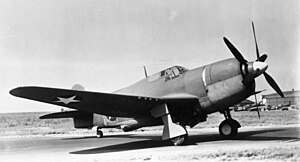| This article includes a list of references, related reading, or external links, but its sources remain unclear because it lacks inline citations. Please help improve this article by introducing more precise citations. (August 2024) (Learn how and when to remove this message) |
| XP-62 | |
|---|---|
 A Curtiss XP-62 on the tarmac A Curtiss XP-62 on the tarmac | |
| General information | |
| Type | Fighter interceptor |
| Manufacturer | Curtiss-Wright |
| Status | Cancelled 21 September 1943 |
| Primary user | United States Army Air Forces |
| Number built | 1 |
| History | |
| Manufactured | 1943 |
| First flight | 21 July 1943 |
The Curtiss XP-62 was a prototype single-engine interceptor aircraft, that was built for the United States Army Air Forces, by the Curtiss-Wright Corporation. It first flew in 1943.
The design sought to have an improved high-altitude performance and higher speeds, at all altitudes, which was to be assisted by the 18-cylinder Wright R-3350 Duplex-Cyclone engine. It was to be armed with four 20 mm (0.79 in) autocannons, a heavier armament than contemporary USAAF fighter aircraft, and was fitted with a pressurized cockpit.
Design and development
The terms of the contract proposal of 29 April 1941 called for the first flight within fifteen months of the award and meet the following objectives.
- Maximum level flight speed at 27,000 ft (8,200 m) had to exceed 468 mph (753 km/h).
- It was to feature an air-conditioned pressurized cockpit.
- Armament to be either eight 20 mm (0.79 in) cannons or twelve 0.50 in (12.7 mm) machine guns, mounted in the wings.
Two prototypes were ordered; the first designated XP-62 and the second designated XP-62A.
On 2 August 1941, the specifications were amended for the XP-62, reducing the maximum speed to 448 mph (721 km/h) with eight 20 mm (0.79 in) cannons, and increasing the loaded weight by 1,537 lb (697 kg).
During a project review of 1 January 1942, the specification was again revised, with the loaded weight reduced by eliminating four cannons and removing the propeller de-icing equipment.
On 25 May 1942 a contract for 100 P-62 fighters was awarded. However, on 27 July 1942, before production could begin, the contract for the P-62 was terminated by the USAAF because of the effect on deliveries of Curtiss-built Republic P-47G-CU Thunderbolts.
While work on the XP-62A continued, it progressed slowly, owing to its low priority. Delays in delivery of the pressure-cabin supercharger and engine modifications delayed the first flight until 21 July 1943. Only a limited amount of flight testing was carried out before the XP-62A was canceled on 21 September 1943 and full performance characteristics were not obtained. The prototype was scrapped in early 1944.
Variants
- XP-62
- Prototype, 8 x 20 mm cannons
- P-62A
- Planned initial production version, 100-aircraft contract cancelled
Specifications (XP-62)
Data from Curtiss Aircraft 1907–1947
General characteristics
- Crew: 1
- Length: 39 ft 6 in (12.04 m)
- Wingspan: 53 ft 8 in (16.36 m)
- Height: 16 ft 3 in (4.95 m)
- Wing area: 420 sq ft (39 m)
- Airfoil: root: NACA 66-118; tip: NACA 66-113
- Empty weight: 11,775 lb (5,341 kg)
- Gross weight: 16,650 lb (7,552 kg)
- Powerplant: 1 × Wright R-3350-17 Duplex Cyclone 18-cylinder air-cooled radial piston engine, 2,300 hp (1,700 kW)
- Propellers: 6-bladed contra-rotating constant-speed propeller
Performance
- Maximum speed: 448 mph (721 km/h, 389 kn) at 27,000 ft (8,200 m)
- Range: 1,300 mi (2,100 km, 1,100 nmi)
- Service ceiling: 37,500 ft (11,400 m)
- Time to altitude: 15,000 ft (4,600 m) in 6.9 minutes
- Wing loading: 35 lb/sq ft (170 kg/m)
- Power/mass: 0.16 hp/lb (0.26 kW/kg)
Armament
- Guns: 8 x 20 mm (0.787 in) cannon
See also
Related lists
References
- ^ "Curtiss XP-62". National Museum of the U.S. Air Force. 2009. Archived from the original on 10 October 2012. Retrieved 2 September 2024.
- Bowers, Peter M. (1979). Curtiss aircraft, 1907-1947. London: Putnam. pp. 327–331. ISBN 0370100298.
- Lednicer, David. "The Incomplete Guide to Airfoil Usage". m-selig.ae.illinois.edu. Retrieved 16 April 2019.
- Green, William. War Planes of the Second World War – Fighters, Volume 4. London: Macdonald. 1961.
External links
- Curtis XP-62 – National Museum of the USAF
- Wind-Tunnel Tests Of The 1/9-Scale Model Of The Curtiss XP-62 Airplane With Various Vertical Tail Arrangements – DTIC
| Curtiss and Curtiss-Wright aircraft | |||||||||||||||||||||||||||||||||||||||||||||||||||||||||
|---|---|---|---|---|---|---|---|---|---|---|---|---|---|---|---|---|---|---|---|---|---|---|---|---|---|---|---|---|---|---|---|---|---|---|---|---|---|---|---|---|---|---|---|---|---|---|---|---|---|---|---|---|---|---|---|---|---|
| Manufacturer designations |
| ||||||||||||||||||||||||||||||||||||||||||||||||||||||||
| Operator and role |
| ||||||||||||||||||||||||||||||||||||||||||||||||||||||||
| Designation skipped Not built | |||||||||||||||||||||||||||||||||||||||||||||||||||||||||
| USAAS/USAAC/USAAF/USAF fighter designations 1924–1962, and Tri-Service post-1962 systems | |||||||||||
|---|---|---|---|---|---|---|---|---|---|---|---|
| 1924 sequences (1924–1962) |
| ||||||||||
| Tri-service sequence (1962–present) |
| ||||||||||
| Covert designations | |||||||||||
| Related designations | |||||||||||
| Not assigned • Unofficial • Assigned to multiple types See also: "F-19" • 1919–1924 sequence | |||||||||||